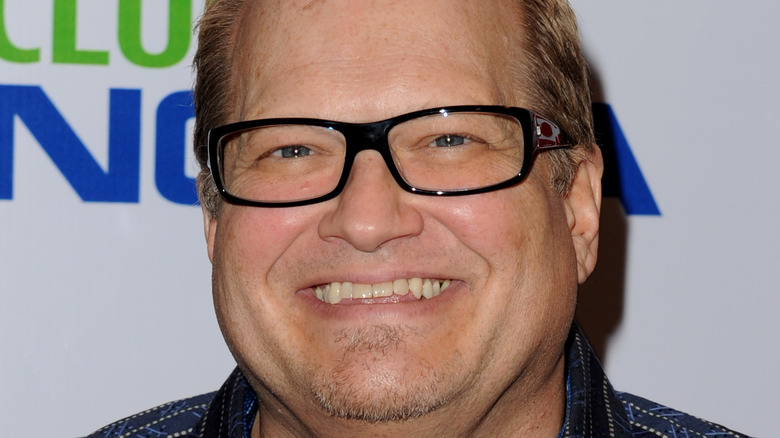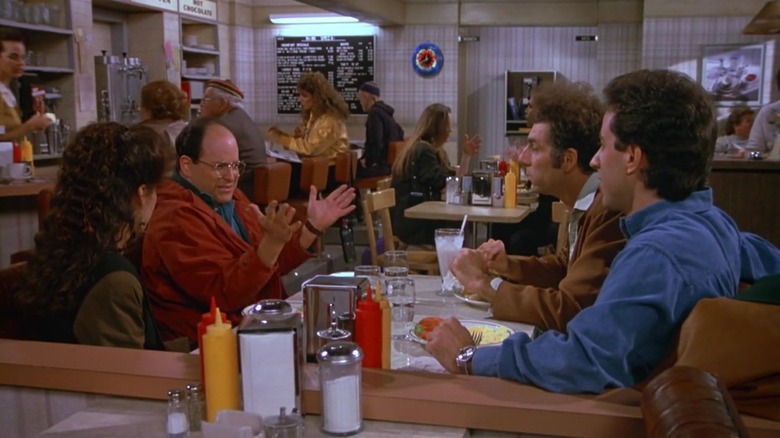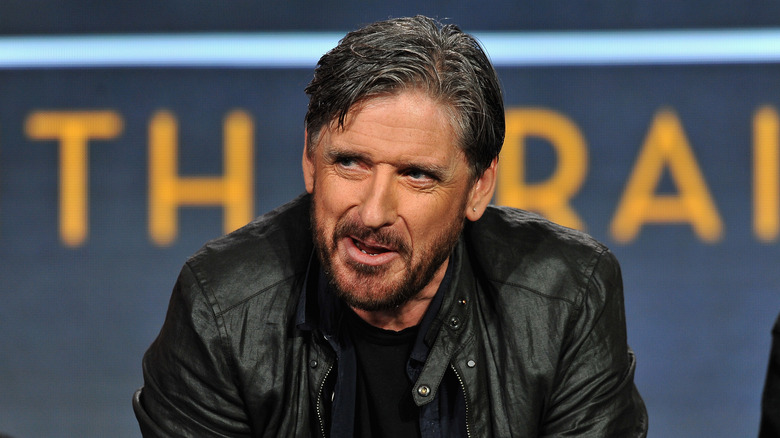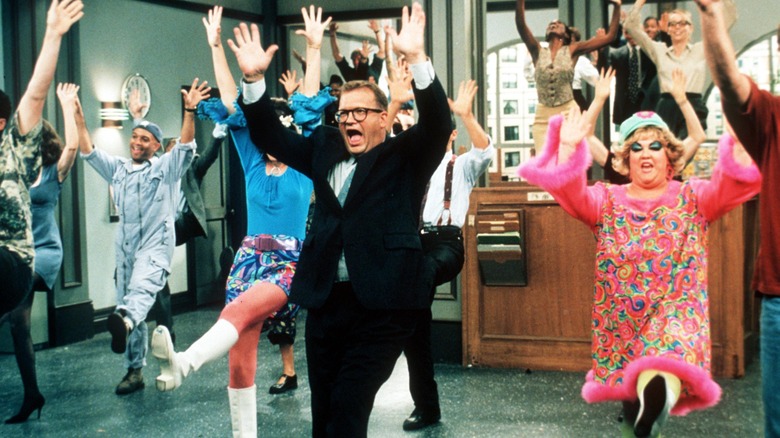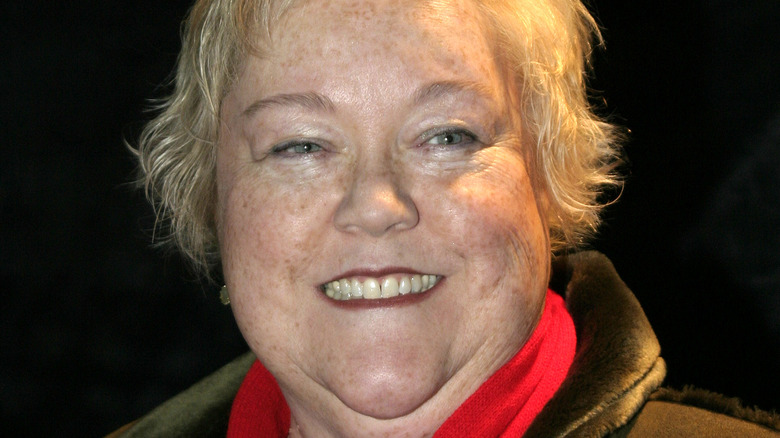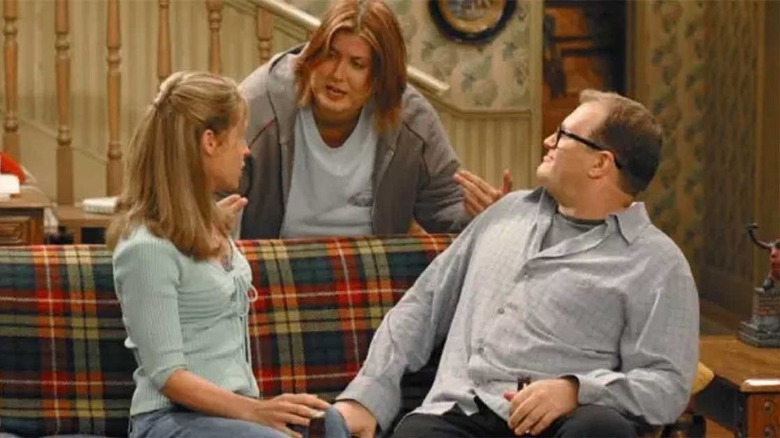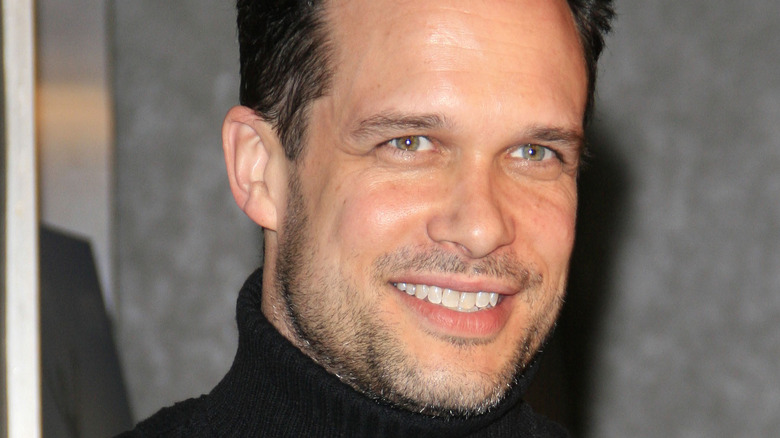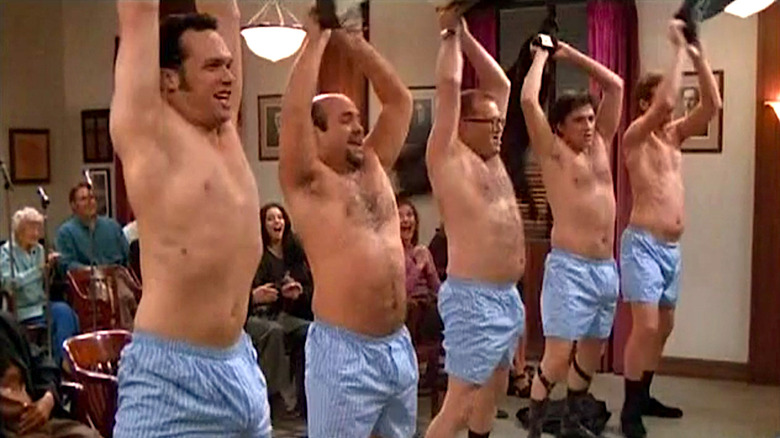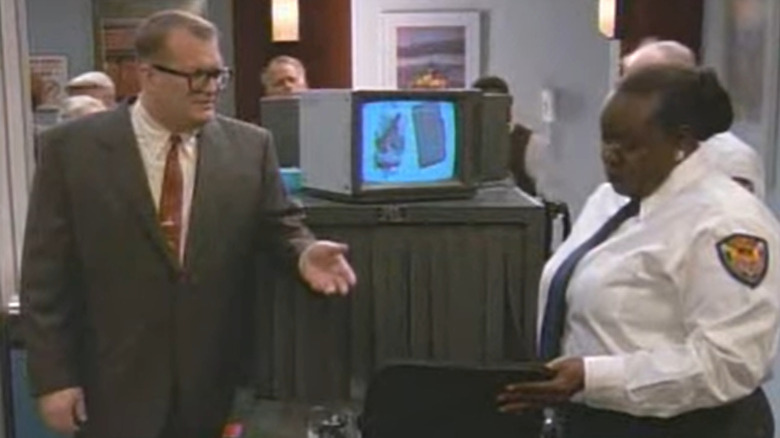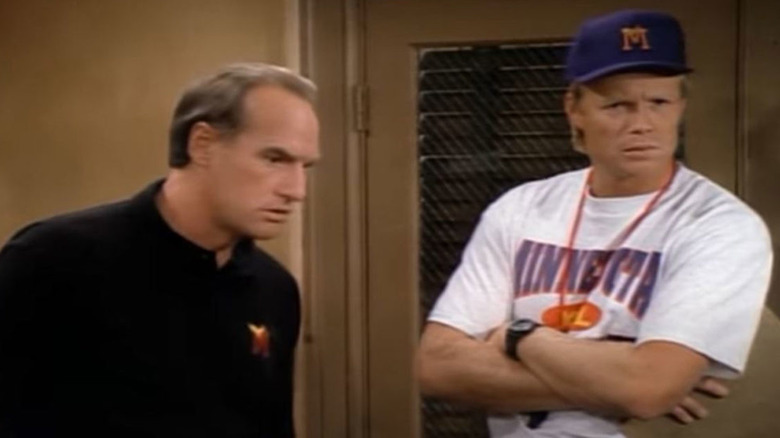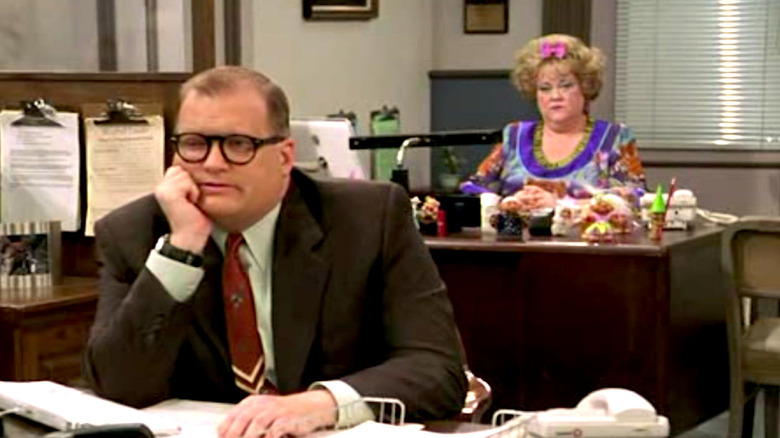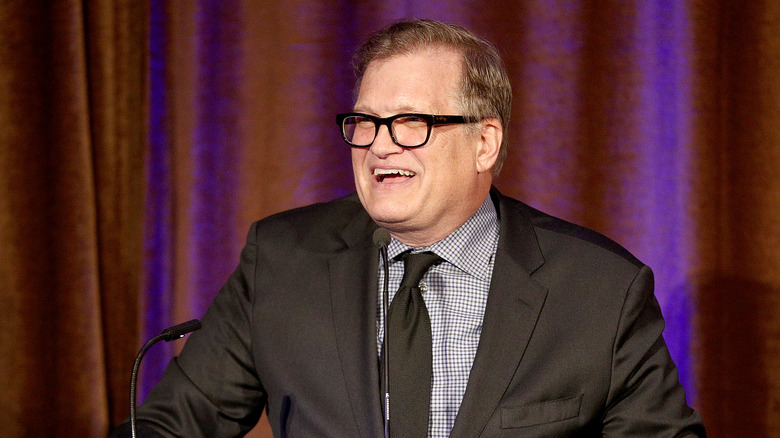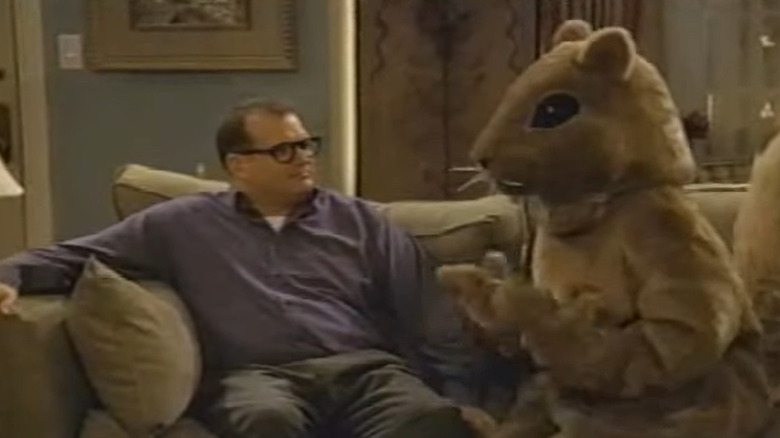The Untold Truth Of The Drew Carey Show
The role of sitcoms in pop culture has changed dramatically over the past few decades. The rise of "prestige television," with its finite plot arcs and cinematic approach to storytelling, has cast a bit of a shadow on the formulaic, laugh-track-infused comedies of yesteryear — the kind of shows that would go on forever as long as the ratings held up.
But there was a time, not so very long ago, when sitcoms reigned supreme on television. From the family hijinks of "Everybody Loves Raymond" to the carefree vibe of "Friends," it seemed like there was a half-hour comedy about nearly every facet of American life. Then in the mid-1990s, in strolled Drew Carey — an unassuming everyman with a new sitcom aptly titled "The Drew Carey Show."
The series told the sad yet funny tale of an average office worker who dreams of a life beyond his cubicle, all while dealing with zany friends and enemies who simultaneously improve and complicate his life with their antics. Despite never being the most-watched show of its day, "The Drew Carey Show" nonetheless held a strong audience of dedicated fans who carried the show through an impressive nine seasons on ABC. Here are some facts about "The Drew Carey Show" that you might not be aware of.
The anti-Seinfeld
Some sitcoms go beyond the realm of mere popularity and become cultural cornerstones, representing an entire generation of sitcoms and — whether directly or indirectly — affecting the shows that follow. "Seinfeld" was one such series in the 1990s, becoming the measuring stick for everything that came after in the genre.
While "The Drew Carey Show" doesn't share that many similarities with "Seinfeld," the latter's influence was felt in an important way by the show's creators. When actor and comedian Drew Carey first approached ABC studios with the pitch for his titular sitcom, he needed to give them a sense of what the series would be about in as few words as possible. Ultimately, Carey chose to describe his show as the opposite of "Seinfeld."
"Every show is like, 'Oh, it's New York yuppies that have minor problems,'" Carey explained in an interview on ABC's "Primetime Live." "This show is about one guy. Dumpy, white guy who lives in Cleveland." It may not have been the most glamorous way to pitch a show, but the folks at ABC liked what they heard and greenlit the series. Carey went on to use his experience in the world of stand-up comedy to deliver a new TV everyman — a character in the tradition of Al Bundy and the early years of Homer Simpson.
Real life on screen
You can't be an everyman office worker on TV without an unreasonable boss to make your life miserable. On "The Drew Carey Show," that boss was Nigel Wick (Craig Ferguson). Wick ruled the roost at Winfred-Lauder — the store where Drew worked in the human resource department — and he quickly became a key piece of the show's core dynamic
Driven by a warped sense of humor, Wick liked to have fun at his job, even if it was at the expense of his employees' peace of mind (usually Drew's). As the series progressed, Wick got himself into increasingly bizarre fixes. He also developed a cocaine addiction and ended up going to rehab. Wick's drug use was mined for comedy on the show, but it had a heartbreaking basis in reality. Craig Ferguson has talked openly about his own struggles with alcohol and drug addiction, which he's said once pushed him to suicidal ideation. Fortunately, Ferguson was able to get his life back on track, going on to find success as an actor, comedian, and perhaps most unexpectedly, a late-night talk show host.
If you or anyone you know is struggling with addiction issues, help is available. Visit the Substance Abuse and Mental Health Services Administration website or contact SAMHSA's National Helpline at 1-800-662-HELP (4357).
If you or anyone you know is having suicidal thoughts, please call the National Suicide Prevention Lifeline at 1-800-273-TALK (8255).
The glasses were all for show
When you picture the eponymous main character of "The Drew Carey Show," one of the first things that comes to mind is probably his thick, black-framed glasses. The spectacles became a big part of the character's everyman image, separating him from the traditionally glamorous Hollywood lead.
They also weren't something that Drew Carey consciously added to his character on the show, but rather something that he simply carried over from his personal life. Carey wore glasses until 2001, when he decided to get LASIK eye surgery to correct his vision. However, the comedian kept wearing them because they had become such a central part of his persona. "As you notice, [my] glasses are fake," Carey explained in an interview with the Maloney-Shamie Vision Institute. "I decided to get LASIK surgery because I wanted to destroy my career."
He said that he had gotten tired of wearing glasses in his personal life because they got in the way of more physical activities like scuba diving. The surgery was successful, but the glasses remained on "The Drew Carey Show." They also gave him an easy way to disguise himself when he didn't want to be recognized in public, simply by taking off the glasses.
The villain who was just too good
While Mr. Wick occasionally gave the main characters on "The Drew Carey Show" a hard time, the main villain of the show for much of its run was the delightfully unhinged Mimi Bobeck, played by Kathy Kinney. Clad in the brightest clothes and makeup, Mimi was like the anti-Drew — a loud, brash person who always got the last word in and who could make even her superiors quake in their boots.
The antagonistic relationship between Mimi and Drew was a true highlight of the series, with the childish volleys of insults they threw at each other sparking many of the show's best comedic moments. And yet, the secret sauce of the Drew-Mimi rivalry was not something the creators of the show even had in mind while developing the series.
In an interview for a segment on "Oprah: Where Are They Now?" (via HuffPost), Kinney described her initial role on "The Drew Carey Show" as "a one-shot deal." Mimi was initially supposed to only appear in the series pilot as a prospective employee who tries and fails to get a job at Winfred-Lauder. But the producers liked what Kinney did with the character so much that they made her a series regular.
Lessons learned from a fat suit
The turn of the century was a different time for pop culture, with a lot of jokes that would be deemed offensive today simply seen as par for the course. On "The Drew Carey Show," one specific type of joke that got a lot of play was "fat-phobic" commentary, usually directed at Drew or Mimi.
But they weren't the only characters to be made fun of for their weight. Kate Walsh had a recurring role as Nicki Fifer, Drew's on-again, off-again girlfriend. One of the storylines involving Nicki had the character put on a bunch of weight, and to make the scenes work, Walsh wore a fat suit — an experience the actress said had a major impact on her.
"I remember going out to eat while wearing the fat suit," Walsh recalled in an interview with Women's Health, "and some people stared at me like I was an animal going to the trough. People can be really cruel." Walsh shared that she had struggled with weight and body image issues previously in her personal life, but that the public response to the fat suit gave her an even greater sense of perspective.
Saved by the Hillbillies
While the main focus of "The Drew Carey Show" was always its titular lead, the series would have been incomplete without its wacky cast of supporting characters. To help Drew through his sad-sack life, he had to have his loyal friends by his side — Lewis (Ryan Stiles), Kate (Christa Miller), and Oswald (Diedrich Bader).
Bader in particularly had a breakout experience on the show, which helped him earn roles in major comedy hits like "Office Space" and "Napoleon Dynamite." Before landing the part that made him a household name, however, Bader had been knocking around Hollywood playing whatever roles came his way. One such appearance in 1993's "The Beverly Hillbillies" proved to be particularly significant. Despite not making much of an impression on audiences or critics (per Rotten Tomatoes), the movie did bring Bader to Drew Carey's mind when he was looking for an actor to play Oswald.
"I got 'Drew Carey' from 'The Hillbillies,'" Bader told The Young Turks in an interview. "Drew liked 'The Hillbillies' so much that he cast me." Before doing "The Beverly Hillbillies," Bader had already done six other pilots for various television series that never came to anything. The actor was getting ready to throw in the towel and move back to his hometown when he was cast in the movie, which in turn led him to the role of Oswald. The rest is history.
A naughty cameo
Despite being seen as a family-friendly series, "The Drew Carey Show" managed to be pretty risque at times. One of the best examples of this occurs in Season 3's "The Dog and Pony Show" when a series of hijinks ends up with Drew and the other main male characters putting on a striptease show.
The famous scene takes place in front of a room full of screaming women, with Mr. Wick, Drew, and the rest of the guys dressed up as naughty male delivery men bearing "packages." In the scene, at the back of the room, you can see a group of men also enjoying the show, all the way up until the police raids the building and nips the proceedings in the bud.
The men shown standing in the back are actually actors Mark Addy, Paul Barber, Steve Huison, and Hugo Speer – all of whom appeared in the 1997 British comedy "The Full Monty," which was the main inspiration for the striptease storyline on "The Drew Carey Show." The guest actors were originally supposed to participate in the action on screen, but foreign labor laws in the entertainment industry forced them to keep their participation to a minimum.
The gag based on real life
As the lead actor and co-creator of "The Drew Carey Show," it's natural that Carey's own real-life experiences would play into various plotlines. However, there was one particular incident from Carey's personal life that made its way onto the show that the comedian wasn't too thrilled about.
In the Season 4 episode "Good Vibrations," Drew tries to get on a plane at the airport, but he's left red-faced when the authorities discover a vibrator inside his suitcase, which had been planted there as a prank. The incident leads to much embarrassment for Drew, mirroring the actor's own reaction when his castmates played the joke on him for real.
"Someone played a prank on Drew," Christa Miller told Jon Stewart in an interview, explaining that someone had planted an unnamed but very long metal object in her co-star's bag on a trip to Las Vegas, which in turn inspired the scene on the show. "Drew didn't think it was funny [when it happened in real life]," Miller continued. "Funny on the show, not funny off the show."
An attempt at a crossover
Today, people are very familiar with the concept of shared film and TV continuities thanks to the popularity of the Marvel Cinematic Universe and other franchises like it. But pop culture crossover adventures are nothing new. Television studios have long made it a habit to produce episodes where characters from separate shows overlap in search of a ratings bump.
ABC had the idea to do one such crossover in 1997 titled "Viva Las Vegas." The central conceit of the episodes was that the main characters from four of the studio's most popular series — "Grace Under Fire," "Ellen," "Coach," and "The Drew Carey Show" — all ended up in Las Vegas on the same day and therefore had an excuse to pop up in each other's shows for a (somewhat) interconnected storyline. Ultimately, the crossover wasn't a huge success, and it was dogged by rumors of tensions behind the scenes. ABC didn't try any more shared storylines with that particular quartet of shows, but the concept of crossover episodes continued to find favor with studios.
Overstaying its welcome
After nine seasons, "The Drew Carey Show" finally came to an end in 2004 with the airing of its series finale, simply titled, "Finale." The lack of effort put into the title reflects the larger sense of apathy that surrounded the series in its last season. Following a pretty successful start, "The Drew Carey Show" reached its peak popularity around the third and fourth seasons. After that, though, ratings began to drop, and they had plummeted by the time the ninth season was being planned. A 2003 article from The Washington Post described the series as "dead-but-still-twitching." At that point, it wouldn't have been out of the question for ABC to simply discontinue the show due to lack of interest, but contractual obligations kept the show on air until 2004. This tension between the creators and executives sparked some behind-the-scenes animosity in the show's final days.
"If the people who put the show on the air at ABC were still there, we'd still be on the air, and we'd still be a hit," series director Sam Simon stated in an interview with the Tampa Bay Times after the show ended. "It's just an embarrassment to new regimes when other shows do better than the ones they put on the air." The tension with the network apparently had an unexpected positive side effect too, however. Simon said it was "liberating" to film the finale without much corporate oversight and that the creators were able to take narrative and directorial risks while ending the series.
A military background
The lead character of "The Drew Carey Show" was designed to be the most ordinary, everyday working schlub you could imagine. From his buzzcut hair to his oversized glasses, Carey had perfected his "everyman" look in his days as a stand-up comic, which he debuted on TV in 1991 on "The Tonight Show Starring Johnny Carson."
But the roots of that now-iconic look go back much further, and they aren't what you might think. Before moving to L.A. to try his luck in the entertainment industry, Carey was in the Marine Corps. It was there that he made his start as a stand-up comic, stating in an interview with Military.com that, "I was looking for a way to make some more money, and it was suggested that I try using my jokes."
The buzz cut was a requirement from his Marine days that Carey carried over into his stand-up persona, along with the glasses and the self-deprecating sense of humor that first became a hit among his fellow Marines. Carey continues to speak fondly of his time in the military, having expressed appreciation for the "regimen and camaraderie" that came with the lifestyle. It's little wonder then that he's still involved with the military services, frequently hosting gigs with the USO.
A couple of controversies
Over the years, "The Drew Carey Show" established a reputation for being extremely family-friendly, perhaps due to the cuddly perception of its lead character. But despite wanting to play the mild-mannered everyman, Carey also had strong views on the subject of free and open speech and was not afraid to create storylines likely to rub some people the wrong way.
Two such storylines that garnered heavy criticism involved the show's depiction of Polish people and anti-fur activists. The series' creators were showered with complaints from the Polish American Congress over a storyline where Mimi meets a disreputable man presented as the "King of Poland," and again by an animal rights group called the Ark Trust with accusations that the show "makes fun of animal-rights activists." Both plotlines were deemed problematic, and the response to them might have been even more severe in today's media landscape. Back then, though, Carey was largely unmoved by the protests. "F*** them," he said bluntly to Esquire about the show's detractors, claiming that not every Polish character on TV needed to be portrayed as an "engineer or lawyer" and claiming that the Ark Trust's criticisms didn't really mean anything. Despite Carey's claims of ambivalence, the King of Poland scenes were cut from subsequent TV runs, signaling that the comedian may truly have taken things too far.
It was all a dream
The official series finale of "The Drew Carey Show" was considered rather underwhelming, due to studio indifference and the general sentiment that the show had outstayed its welcome. But while the legacy of the show itself might fall a few steps short of iconic, it successfully launched the careers of a host of noted television personalities.
Two of those personalities were Drew Carey and Craig Ferguson, both of whom went on to become successful TV show hosts. Ferguson succeeded Craig Kilborn on CBS' "The Late Late Show," while Carey became the host of "Whose Line is it Anyway?" and later "The Price is Right." Both comedians continued to be good friends, even swapping jobs for a day once in honor of April Fool's Day.
Their bonhomie also gave fans of "The Drew Carey Show" a second and more zany series finale 10 years in the making. On the final episode of "The Late Late Show with Craig Ferguson," Carey made a guest appearance in a skit where it was revealed that the last 10 years had all been a dream, and that in reality, Carey and Ferguson were still living their lives as their fictional alter egos on "The Drew Carey Show."
